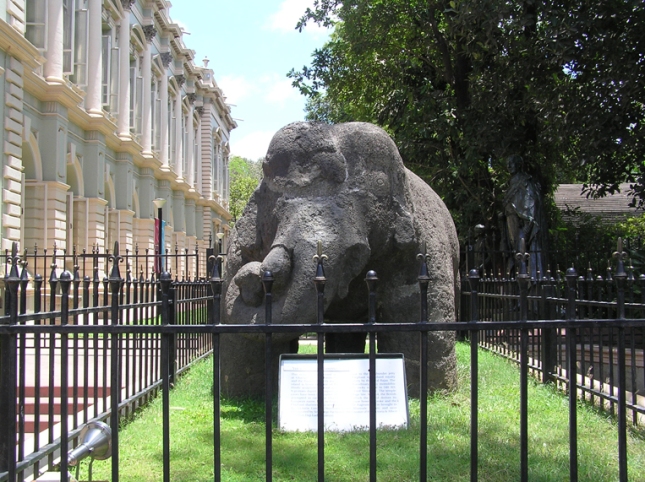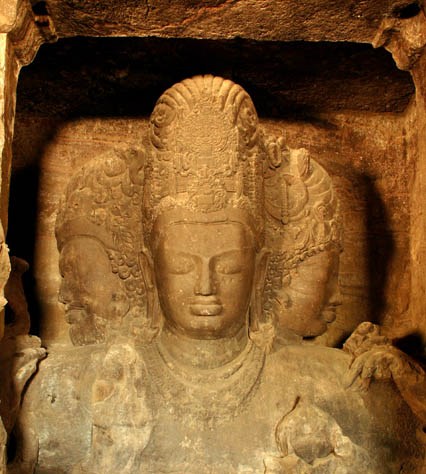Elephant Caves are a network of sculpted caves located on Elephanta Island and dates back to 600 AD. This island is located on an arm of the Arabian Sea and consists of two groups of caves-the first is a large group of five Hindu caves and the second one includes a smaller group of two Buddhist caves. It is 1.5 miles in length with two hills that rise to a height of about 500 feet. It is located about 7 kms from Mumbai’s mainland shore.
Locally known as Gharapuri, which means the city of caves, it was a worship place for Hindus. When the Portuguese arrived, they named this island Elephanta because of a giant statue of an elephant at the entrance of the caves. This statue now rests in the Bhau Daji Lad Museum in Mumbai. There were many paintings inside the caves, but now only their traces remains. In 1987, these caves were given the status of a UNESCO World Heritage Site to preserve the artwork and are currently maintained by the Archaeological Survey of India.
Through ferry or boat, one can reach there in one hour from the Gateway of India. Many visitors visit each year to see the exquisite sculptures of the caves. The cave complex consists of shrines, courtyards, inner cells, grand halls and porticos arranged in the elegant symmetry of Indian rock-cut architecture, and filled with delicate stone sculptures of Hindu Gods and Goddesses.
At the entrance to the caves, there is the famous Trimurti, the celebrated trinity of Elephanta: there’s Lord Brahma (the Creator), Lord Vishnu (the preserver) and Lord Shiva (the destroyer). Unfortunately, many of the sculptures inside the cave had been damaged by irreverent Portuguese rulers who took potshots at Hindu Gods with their rifles. There are few sculptures that are still in one piece.
These caves are divided into three main parts – the main hall, east wing shrine and the west wing shrine. The main hall contains sculptures related to Ravana lifting Kailash, Shiva-Parvati in Kailash, Ardhanarishvara, Trimurti, Gangadhara, Wedding of Shiva, Lord Shiva slaying Andhaka, Nataraja, Yogishvara and Linga. The east wing shrine have Kartikeya, Matrikas, Ganesha and Dvarapala. The west wing shrine includes Yogishvara and Nataraja.
The types of caves and the sculptures shows that different dynasties held their sway over this island, namely, the Konkan-Mauryas, Trikutakas, Chalukyas of Badami, Silaharas, Rashtrakutas, Kalyani Chalukyas, Yadavas of Deogiri, the Muslim rulers of Ahmedabad, Marathas and then by the Portuguese.
It is thus a major tourist attraction. For tourists, the caves open from 9 A.M. to 5 P.M. and are closed on Monday.







bnomadic
August 16, 2013 at 1:00 pm
Lovely description and images. Have some lovely memories associated with this place. Way back in 1997. Thanks for sharing. Looking forward to reading more.
http://www.bnomadic.wordpress.com
Swati Singh
August 17, 2013 at 4:46 am
Thanks for visiting 🙂
Grace
August 16, 2013 at 3:34 pm
Wonderful images and truly fascinating history Swati.
Swati Singh
August 17, 2013 at 4:45 am
Thank you 🙂
seniorhiker
August 16, 2013 at 3:56 pm
This is very interesting. The elephant statue is quite impressive, and I can see how it gave the island its name. It’s a shame that so many of the statues were damaged by people who did not appreciate their meaning or beauty.
Swati Singh
August 17, 2013 at 4:45 am
Thanks 🙂
Minoru
August 18, 2013 at 10:37 am
Hi! Nice captures. The Buddism statue has very solemn face. I have very copplicated feelings to see damaged statues. Thanks for sharings.
Tom
August 27, 2013 at 9:11 am
Wow such an amazing place, the sculptures are carved so carefully with many details, I really love ancient cultures, now I have another reason to come back to India!!! Thank you for sharing.
frizztext
September 9, 2013 at 11:36 am
big respect for this old culture!
Linda W.
October 23, 2013 at 4:56 am
It’s sad that people are ignorant enough to damage great art. Nice pictures though.